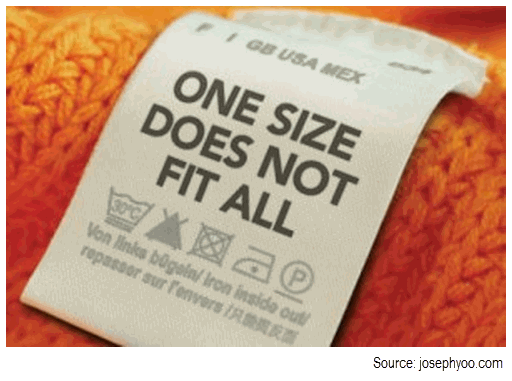Disclaimer: The only place OSFA should be used is on a clothing label (and even then it’s questionable).
In our experience, it is the opposite that is true: One size fits one.
Take Learning and Development for example. Participants on any programme (face to face or online) will come with a variety of preferred learning styles. Some learn using visual aids; diagrams, models, graphs, pictures and video. Others are auditory learners, preferring to listen to the dialogue and will find things come alive for them through story telling and the spoken word. Then there are the kinesthetic learners who learn by doing. These learners prefer activities where knowledge is applied; role plays, practise sessions, labs etc.
You’d be forgiven for thinking the paragraph above contained the complete list of learning styles but did you know there are in fact 7 recognised learning styles?
They are:
- Visual (spatial): You prefer using pictures, images, and spatial understanding.
- Aural (auditory-musical): You prefer using sound and music.
- Verbal (linguistic): You prefer using words, both in speech and writing.
- Physical (kinesthetic): You prefer using your body, hands and sense of touch.
- Logical (mathematical): You prefer using logic, reasoning and systems.
- Social (interpersonal): You prefer to learn in groups or with other people.
- Solitary (intrapersonal): You prefer to work alone and use self-study.
It’s important to note that we are all a mix of the above, we have more than one preferred style.
Overlay on this the pace at which people prefer to learn. People need time to inspect, disseminate and file new information and this all occurs in the brain at different speeds. Most programmes have reflection activities built into them to allow for this and a skilled facilitator will recognise participants whose learning speed is faster or slower than the group and adjust accordingly.
However, it’s how each person shows up that has the biggest impact on any learning. We filter new information through our prior experience, our beliefs, previous knowledge and our perspectives of the world we live in. No two people will have had exactly the same life experiences, gained exactly the same knowledge and hold exactly the same world view.
Therefore we should approach every interaction acknowledging the unique individual that stands before us, remove the OSFA label and replace it with “Made for you”.
Learning Styles definitions courtesy of https://www.learning-styles-online.com/
Share this Post

